Lunch With... Paul Tracy: IndyCar's straight-talking charger
This ever-determined, hard-charging Indycar driver didn’t always mind his Ps and Qs but invariably gave his all in the cockpit

Michael McNamara
These days your average professional racing driver tends to be slight and slender. He is unfailingly polite to team personnel, to sponsors and to rivals, and speaks to the media in unexceptional sound-bites while a PR holds his elbow. Behind the scenes a team of shrewd legal brains guards his business and financial interests, while his job is to be publicly well-behaved.
So if, out of the cockpit, he seems bland and predictable, that’s the price of motor sport’s ever-increasing commercialisation.
But Paul Tracy was never your average professional racing driver. For a start, he’s a big guy: when fully race-fit, he carried at least a stone more than his rivals. His driving style was always aggressive, and face to face he could be aggressive too. He spoke his mind, especially when he was angry, and became known not only for his speed on the track but for his public arguments off it. For much of his career the nearest he had to a manager was his father – also a man known to call a spade a shovel.
Yet over 18 seasons Tracy scored more than two dozen Indycar victories, driving for the great teams like Penske, Newman-Haas and Forsythe. His unshakeable work ethic saw him clocking up tens of thousands of test miles, always hunting for more speed. And in 2003 he was a dominant Champ Car World Series champion.
Paul lives in Arizona these days, in the expensive Phoenix suburb of Scottsdale, where we meet in the swanky Royal Palms resort for a light lunch at T Cook’s. Nearby he has a fine house, a garage full of classic cars and hotrods, an apartment building or two, a motorcycle parts company and other businesses. But he is a Canadian, born at the end of 1968 to an Irish father and an English mother.
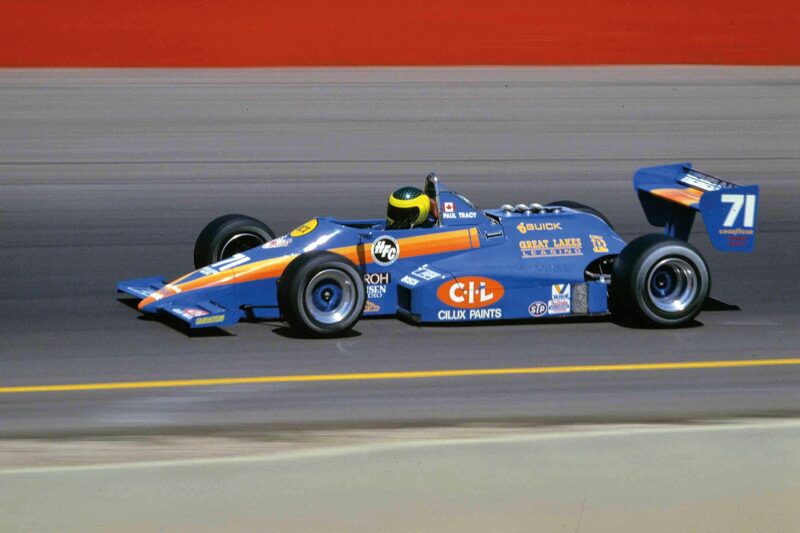
1988 Indy Lights Rookie of the Year
Motorsport Images
“Dad raced a Velocette in Ireland and in England, until he hurt himself in a crash. He emigrated to Canada in the ’60s with his two brothers, and they ended up in Toronto painting people’s houses. Then he heard about the CN Tower being built.” At more than 1800ft, this was the world’s tallest structure until 2007, and is still the tallest in the western hemisphere. “Dad marched into the mayor’s office and said, ‘I want to paint this tower you’re putting up.’ They hadn’t invented Health and Safety then and, if you believe Dad’s story, he and my uncles shinned up the structure, looped rope around their waists and around the nearest bit of steel or concrete, and painted the whole thing. After that he ended up pretty big in the Toronto construction industry.
“So he had the funds to get me into karts. From when I was five we raced every weekend, all through eastern and central Canada and down into the northern US. I loved it. There was nothing else I wanted to do. My dad was working 18-hour days, so it was down to me to prepare the kart, keep it clean, mix the fuel, mount the tyres, learn to build my own motors. If the kart wasn’t ready Friday evening, we didn’t go. Nowadays kids with rich dads go racing and it all turns up for them in a big artic with paid mechanics. They just sit around until it’s time to race, and they learn nothing.
“Well, I was learning. And I was winning a lot of races. When I was only 12 they moved me from the junior class into the seniors, and I started beating the adults.” One source says that out of 82 races this pudgy, bespectacled, relentlessly attacking kid won 74. “In 1983, when I was 14, I went to Germany for the World Championships at Mannheim, on the track run by the Schumacher family. I was racing against Michael and the likes of Mika Häkkinen, Yvan Muller and Gianni Morbidelli – all of us 13 or 14 years old. And in 1984, when the World Championships were in France, I finished sixth.
“As soon as I was 16 we moved up into Formula Ford with a Van Diemen.” Still a schoolboy, Paul won the 1985 Canadian FF Championship in his first season. “It was between me and a guy called Scott Maxwell. We went at it tooth and nail every time. I’d win, or he’d win, or we’d crash into each other. I guess that went on to be the story of my career.
“The next year, 1986, we moved into FF2000. And I also did the last-ever Can-Am race, at Mosport. Horst Kroll was a Toronto guy who raced in Can-Am with a Frissbee, basically an F5000 Lola single-seater with a huge full-width aerodynamic body. One day my dad was in Horst’s repair shop picking up some bits for his Porsche road car, and Horst said, ‘Does your boy want to drive my spare car at Mosport?’ That was a Frissbee too, so I went from 150bhp in an FF2000 to 550bhp from a full-house V8. And the first practice session was in the rain. I was sitting on the floor with a thin sheet of foam under me, and this thing did 180mph down the straight. Well, I qualified on pole and won the race. While I was leading a front tyre started blistering, so I eased my pace, and the guy behind me got past. So I forgot about the tyre and went for it, and I got past him again. I was 17 then.”
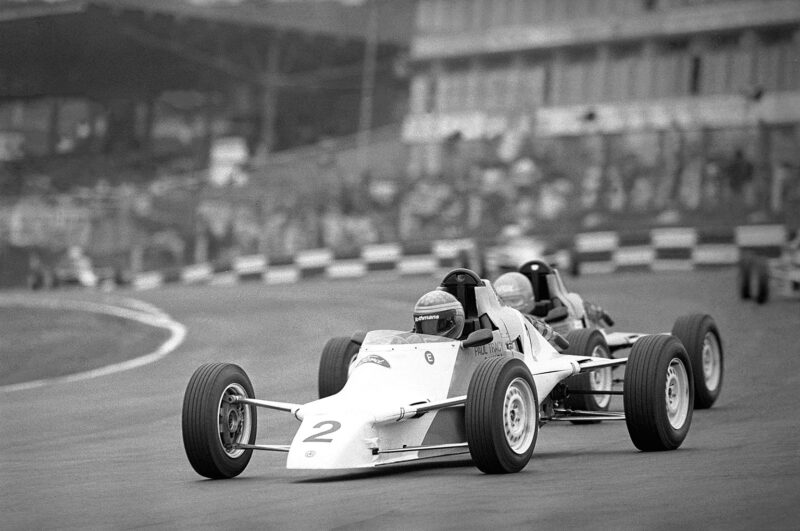
Impressing in 1986 FFord Champions race at Brands
Motorsport Images
The same year Paul came to England for the Champion of Champions race on the Brands Hatch Grand Prix circuit. This put the top Formula Ford drivers from every country in identical Van Diemens in a bid to find the world’s best. “Because I’d never been to Brands I walked a lap with my dad. As we got to Clearways he said, ‘This’ll be flat.’ I said, ‘No way is this flat.’ We had a big argument, and he said, ‘If you’re not prepared to take this flat, we might as well go home.’ So I tried to take it flat in practice, and crashed. After they’d mended the car I had to start near the back of the 25-car grid.” It was only a 10-lapper, but Paul passed nine cars in the first two laps, four of them in one move at Dingle Dell. He continued to pass cars right and left, and ended up fifth at the flag.
He came back to the UK to race a works FF2000 Van Diemen in the winter Grandstand Series, scoring some strong placings. “I lived at [Van Diemen boss] Ralph Firman’s house, and hung around at the factory running errands, doing odd jobs. Then I went to New Zealand for the Formula Pacific series, 10 races in five weekends, using a Ralt owned by Graeme Lawrence. I won the last two rounds and ended up third equal in the series with David Brabham.
“For 1988 I graduated to Indy Lights [then called the American Racing Series]. This used March F3000 chassis with 450bhp Buick V6 engines, so it was not unlike European F3000. My very first race was Phoenix, and I won it. I ended up getting Rookie of the Year. For 1989 my dad decided we should have our own team and it was a disaster, but for 1990 I signed with a Canadian team, Landford Racing, and I had a brilliant engineer called Burke Harrison. I dominated the series, won nine out of the 12 rounds, took seven poles, and got the BRDC Bruce McLaren Trophy for the best performance by a Commonwealth driver. I was 21 and I was American Racing Series champion. This had to be the gateway for me to move up into Indycar.
“But it didn’t work out like that. At the end of 1990 I had a really good test with Truesports at Mid-Ohio. It felt faster than Indy Lights, of course, but when you’re young and desperate to move on you don’t think about anything except going as fast as the car will go. They offered me a three-year contract, but their sponsor was Budweiser, and as I was barely 21 [the minimum drinking age in the US] they blocked it, saying I was too young for them to promote me.
“Indy Lights had cost about $500,000 a season, and my dad got sponsorship from some of the paint companies he dealt with. You know, ‘I’ll buy $2 million worth of paint, I’ll pay you $1.5 million for it and put your name on the car.’ But Indycar was in a different league, and too expensive for my dad to cover. He tried to get backing from various Canadian companies, but three weeks before the first US round of 1991 at Long Beach we still had nothing. So my dad stumped up $100,000 to rent a car from Dale Coyne to do that one race. It was a pipedream: let’s get there, and make enough prize money to get to the next race.” On the Long Beach streets Paul qualified well, but in the race a water pipe broke, and the engine blew. No more pipedream.
“I reckoned that was the end of Indycar for me. I sat on a kerb, feeling really low, and a guy in Penske uniform rode up on a scooter. He said, ‘Hey, Roger wants to see you in his trailer after the race.’ Sounded like I was in trouble, maybe I’d carved up Rick Mears or Emerson Fittipaldi, Penske’s drivers. I went to the Penske trailer, and Roger said, ‘What do you want to do?’ I said, ‘Race is what I want to do.’ He said, ‘I’ll call you in a few weeks. Don’t tell anyone we’ve spoken.’
“I didn’t know what that meant, so my dad and I carried on trying to find a sponsor. Nothing doing. Then one evening in May my dad comes in from work and says, ‘Get in the car. Penske called, he wants to see us tonight.’ We drive 250 miles to Detroit, sit down at 11.30 with Roger and his top guys Walt Czarnecki and Dan Luginbuhl, and they pass over a contract.
“It was for five years. But they wanted a test driver, there were no guarantees of any racing. And the money was really low: starting at $25,000 a year, going up another $25,000 each year. Dad and I said we needed a promise of some racing. But they said, ‘We have 20 other kids lined up waiting to sign if you don’t. It’s sign now, or forget it.’ So we signed. I don’t think we were in there 10 minutes.
“They flew me into the Meadowlands race to announce I’d joined the team as test driver, and the next day I was at the Michigan Speedway doing a 500-mile engine endurance test. I was fast straight away. Then we went to Mid-Ohio: Emerson came to that one, and I was faster than him on all three days, which made for some head-scratching. But Emerson was cool about it. He and Rick were always open and friendly with me. Even when I got to racing with them they’d share set-up details, never treated me as a threat.
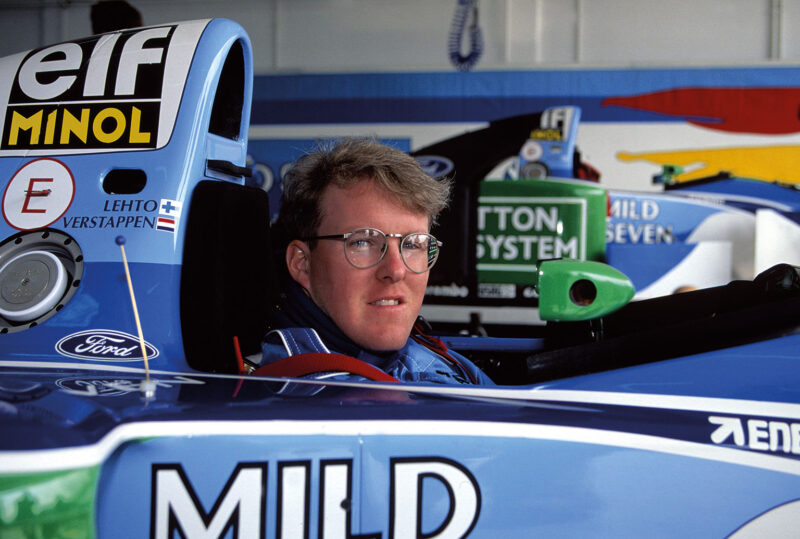
Tracy was quick in 1994 Benetton F1 test, but did not like the deal
Motorsport Images
“The team could see I was quick, so after the first few tests they said, ‘We’re going to run you in the third car at the Michigan 500 in August.’ This was the really big moment for me: racing for Penske. I was in one of the previous year’s cars, and I qualified well, in eighth place. And in the race, on lap three, I hit the wall.
“The thing was, in all my testing I’d been running on my own, and this was my first time in traffic, on an oval, in the draft. I got too close to the car in front, lost grip, it slid, I corrected, and it went in head-on. Smashed my left leg badly, and I ended up in hospital with a rod and screws in my leg.
“I thought I was out of a job. Then the team called and said, ‘Hey, we want you for a test at Michigan’. I show up on crutches, I can’t bear any weight on my left leg, but it only had to push the clutch. I could still work the throttle and brake with my right. Along the wall at Turn 4 I see this big mark looking at me, my mark. That made me nervous. In all the crashes I’d had, I’d never hurt myself before. I got in the car, and it was one of the few times in my career that I was really scared. But pretty soon I got the speeds up. I did the 500-mile test, and they reported back to Roger that it had gone great. I tested throughout the summer, and in October Roger decided to give me another chance and run me at Nazareth. I finished seventh, ahead of both Emerson and Rick.
“In 1992 I was still in a testing role, but they ran me at Phoenix and I was fourth there. Then came the Indy 500. That year it was really cold, and there were lots of accidents because nobody could get any tyre temperature. Rick and Emerson both crashed, but I was running about sixth at half-distance when my gearbox failed. After that Rick had trouble with a broken wrist and I filled in for him. He was back for the Michigan 500, along with Emerson, so I was the No3 again. But I went like I was No1. I led a lot of the race, then I had an understeer problem and Scott Goodyear got past me, but I finished a close second, and I lapped everybody else. That laid the ghost of Michigan for me. At the end of the year Rick announced his retirement, so it looked good for me to get a full-time race seat.
“All this time I never felt a real part of the team, I felt like an outsider. I think Roger liked how committed I was, drive anywhere, any weather, go out and make the car go as fast as it would go. But there was no affection from the team towards me, it was just: ‘Go here, go there, do that, don’t ask questions’. It was still like when they said, ‘Sign this contract or forget it’.
“Well, we go through the winter, nothing, no announcement. When I ask the team what the 1993 line-up is, they tell me, ‘We haven’t made a decision yet.’ I’m still testing, we’ve just got the new car flown in from England and I do three days in it on the Phoenix oval back to back with the old car. Then we go to a little road course the other side of Phoenix called Firebird, where we used to test a lot. I show up at 8am, the track isn’t open yet, and then I see two black limos driving in. Emerson gets out of one, and out of the other steps Ayrton Senna. And I’m told, Ayrton’s driving the car today.
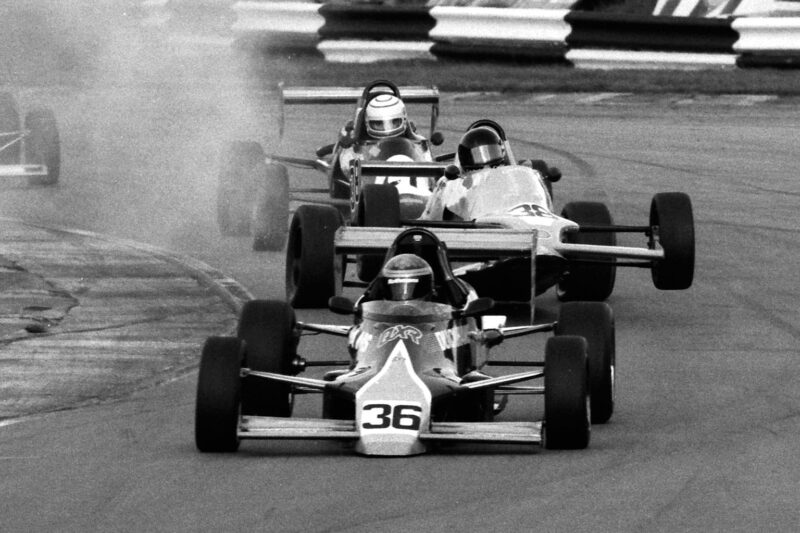
In the thick of 1986 FF2000 scrum with a Van Diemen
Motorsport Images
“His F1 contract with McLaren was up, he was fighting Ron Dennis about money – I think he was asking a million dollars a race – and so Emerson had fixed him an Indycar test with Roger.” According to Penske engineer Nigel Beresford, talking 20 years later, Senna drove the 1992 car for 24 laps and, despite being strange to car and circuit, was 0.6sec faster than Fittipaldi. Tracy was reduced to the role of spectator.
“I’m sitting there thinking, ‘F***, I’m out of a drive’. I don’t know how serious the Senna thing got, but it wasn’t until a few weeks before the first race that my full-time race seat was confirmed alongside Emerson.
“Second race was on the one-mile oval at Phoenix, and I was flying. By quarter-distance I’d lapped the whole field. By half-distance I’d lapped them all twice. In the closing stages Roger comes on the radio and says, ‘Slow down, slow down.’ So I slow down. With 39 miles to go I catch Jimmy Vasser, who I’ve already lapped about four times. I stick my nose under him, but as I’ve been told to take it easy I back out of it. And I lose the car. Into the wall. On the radio there’s just silence. A bad silence. When I get back to the Penske trailer there’s more silence. Nobody saying anything at all.
“To cheer myself up, before the next race at Long Beach I go karting with a buddy to blow off some steam. We tangle on the straightaway and I go end over end. I wasn’t wearing a proper karting suit, I wasn’t wearing gloves, and as soon as I hit the pavement it tore all the skin off my hands and arms and knees. I turned up at Long Beach two days later, and everybody said, ‘What the hell happened to you?’ I thought, I’m in the shit now, but I told them I was training and came off my bike. No way was I going to tell them I was fooling around on a kart.
“I knew I had to redeem myself, so I went into Long Beach like it was my last race. I led from the start, built up a big lead, had to stop when a back-marker’s wing punctured my rear tyre, rejoined sixth, worked back to the front and won, beating Rahal and Mansell. So Roger was happy. And that was only the second anniversary of when I’d been sitting dejected on that kerb. After that I won at Cleveland, Road America, Laguna Seca and my home race, Toronto. Five victories, the same as Mansell, who was champion, and two more than Emerson, who was runner-up. I was third.
“For 1994 Al Unser Jr came on the team. He was a big star, Indy winner, Indycar champion. His dad Al Sr had won two titles for Penske, he and his brother Bobby had both won Indy 500s for him, so the Unsers were thick with Roger. I still felt like the outsider, I was still the No3. That year Penske dominated Indycar: Al Jr won the title, Emerson was second, I was third, but I won three races to Emerson’s one. Of course, I was still on my peanuts contract: the others were on millions of dollars. Then Roger said to my dad, ‘Marlboro’s cutting back, I can’t run Paul next year. We’ll move him across to the Bettenhausen team in one of last year’s cars.’ So my dad re-read the contract, line by line. I couldn’t do anything without Penske’s permission, couldn’t do sports cars, couldn’t pick my nose unless Roger said I could – but Dad found a clause that said Penske couldn’t assign me to another team. So I was free to move.
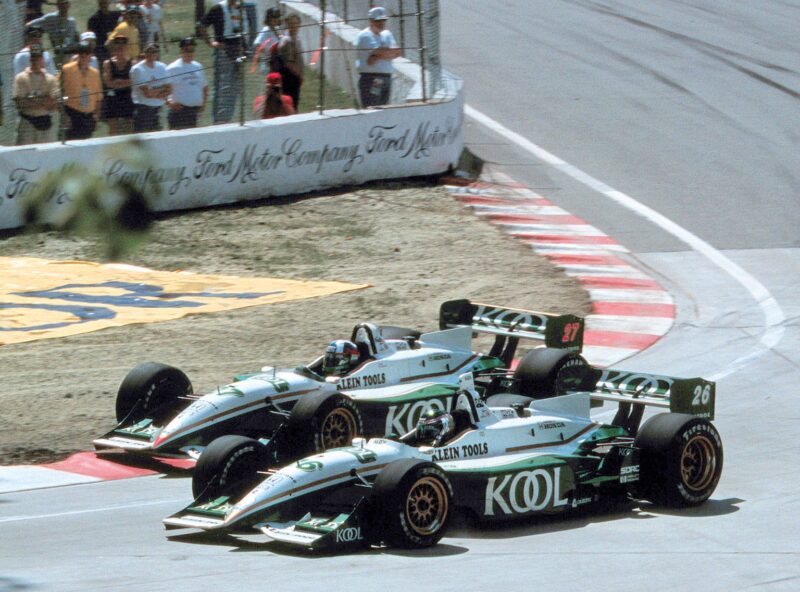
Wheel-to-wheel with 1999 CART team-mate Dario Franchitti
Motorsport Images
“Meanwhile in September Bernie Ecclestone organised an F1 test for me with Benetton. It was at Estoril, after the Portuguese Grand Prix. I get there to watch the race, and Flavio Briatore calls me into his bus and says, ‘Before you can test the car, you have to sign this contract.’ It was all in legalese, but I could see that if I signed Flavio would become my manager. It would bind me to him for the rest of my career. No way. Flavio flies home, so Monday morning I call him and tell him I can’t sign his management deal. He says, ‘Then you’re not getting in the car.’ I don’t know what to do, so I call Bernie. Bernie says, ‘Hold on a moment’, and I hear him get Flavio on the other phone and bark: ‘Put him in the car.’ Twenty minutes later I was in the car.”
The test, alongside Michael Schumacher and Jos Verstappen, went very well. Towards the end of the second day Paul, in a Formula 1 car for the first time, posted a lap that would have put him fourth on the grid for Sunday’s race, comfortably ahead of Verstappen and JJ Lehto (who’d stood in for the suspended Schumacher). “Then Benetton came up with a three-year F1 contract, but it was the old story: testing, no guarantee I’d be racing, and no proper money. Meanwhile Paul Newman and Carl Haas offered an Indycar ride that paid $1.5 million – when Penske had been paying me $100,000. So I went for that. I’d hired myself a manager by now, Dave Stevenson, to look after my contracts, my taxes, all that stuff. First time in my life I’d ever earned any real dollars.
“The 1995 Newman-Haas Lola wasn’t an easy car. Both my team-mate Michael Andretti and I had difficulty making it work.” One of Paul’s more frustrating weekends came at New Hampshire, where he was black-flagged because of an oil leak. He reckoned the leak could easily be mended and wanted to rejoin, but race officials saw it differently, and Tracy’s short fuse burned out. He was fined $2000 for taking two laps to respond to the black flag, $5000 for physical contact with an official, and $5000 for “an obscene gesture”.
“But I won the first round at Surfer’s Paradise, and I won Milwaukee. And at Indy I was fast, running well when the electrics packed up. Meanwhile Penske was in real, real trouble. For the first time ever, in 27 years, no Penske entry qualified for Indy. Al Jr and Emerson were out of it. So Roger summoned me again. ‘I need you to come back. I need somebody who can work 100 per cent, do the testing, find out where we’re at.’ By now Emerson was almost 50 years old, and I guess Al Jr had some problems too.” Unser was later quoted as saying that his failure to qualify at Indy was the event that triggered his descent into alcoholism.
“So Roger re-signed me on a four-year deal with the Penske-Mercedes. Proper money this time: $3.5 million a year. But 1996 wasn’t a great season, and the car was a struggle. Plus I hit the wall at Michigan, broke a bone in my back, missed a couple of races. In 1997 things started well. I gave Penske their first good news for a long time by taking three consecutive wins, all on ovals. That car was brilliant on ovals, but it didn’t work well on road courses. Alex Zanardi was running for Ganassi, and his Reynard-Honda worked well enough on ovals but was fantastic on road courses. And its Firestones were better than our Goodyears. So when it came to the road courses I was in trouble.
“We got to my home race, Toronto, where there was always a lot of interest in me. I drove my heart out all weekend. Best I could do was qualify 14th and finish 10th, while Zanardi, who finished second, piled on the points. Al Jr in the other Penske did even worse: he finished 20th. I got out of the car exhausted and angry, and there was a huge battery of microphones and cameras waiting for me: What was the problem? Why were you so slow? When I’ve had a bad day I can get pretty fiery. I said, ‘The car was a piece of shit today.’ One of the TV guys said, ‘What do you need to fix it?’ I said, ‘A Reynard chassis, a Honda engine, Firestone tyres.’ That went all over the TV and the papers.
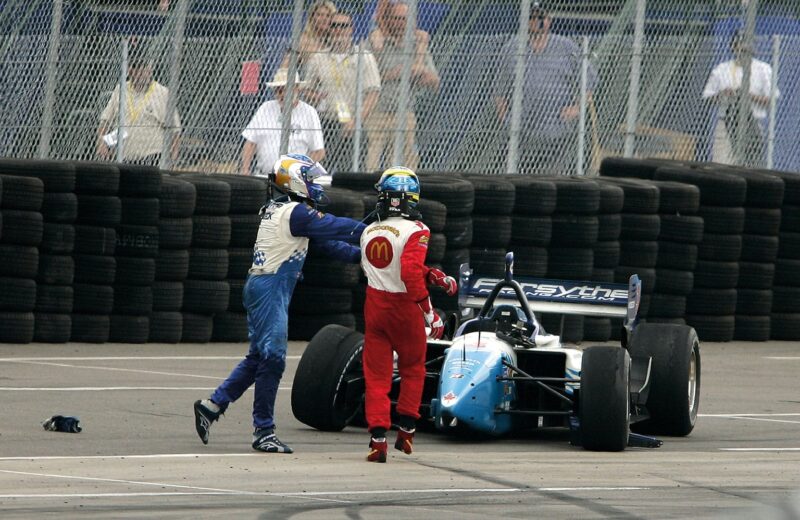
Tracy makes his point after 2006 tangle with Sebastien Bourdais
Motorsport Images
“Near the end of the year I was called to do a test at a little road course in west Michigan called Gingerman Raceway. I did two long days there with the Penske, hundreds of laps changing suspension, changing diffs, trying different wings, and gradually the times got better. Then on the third day a plain white truck rolled in, and there was a Reynard-Mercedes, on Firestone tyres. Roger had borrowed it from Bobby Rahal. I got in, and my first hard lap was quicker than I’d done in two days with the Penske on Goodyears.
“It was so convincing I assumed we were going to get Reynards for 1998. After the last round at Laguna Seca I went into the hospitality truck to say goodbye to everybody, and Roger said, ‘We’re going to start winter testing pretty soon. What do we need for next season?’ I said, ‘With a Reynard chassis and Firestone tyres I’ll win you the championship.’
“A couple of weeks went by, then Dave Stevenson called: ‘Roger wants you to fly into San Diego and meet him at a hotel to have lunch with some potential sponsors.’ I fly down there, Dave meets me at the airport, and he says, ‘I’ve got a bad feeling about this.’ We go to the hotel, go up to this meetings suite, and there’s Dan Luginbuhl, Teddy Mayer [then one of Penske’s vice-presidents] and a corporate lawyer. No Roger, nobody else. We walk in, and they say to me, ‘You’re out.’ Dave says, ‘But we have two years to run on a four-year contract.’ They say, ‘Paul has said publicly that he has no confidence in our package. If he wants a Reynard chassis and Firestone tyres, he can go find them.’ We were in the room all of five minutes, and then we were out on the street.
“Seems my Penske contract included a clause that prevented me from saying anything detrimental about the car, the team, the sponsors, the suppliers. I guess all contracts are like that now: you’re not permitted to speak your mind about anything. So after two years of a four-year, $14 million contract, I was out of a drive. If they’d told me a bit earlier they were firing me I could have put myself on the market, but by then most of the best rides had gone. So it was panic stations. I called Gerry Forsythe, who had been after me, but he’d just signed Greg Moore and Patrick Carpentier. Then I called Barry Green, who had started his own one-car team with Kool, running Dario Franchitti. He called Honda in Japan, and within 24 hours his one-car team had become a two-car team. So I was in a Reynard-Honda on Firestones alongside Dario.
“I had what I wanted, but I was still struggling. Dario and I had a few run-ins, he’d chop me off or we’d bang into each other. It never affected us, we’d just laugh it off, but it sure upset the management. At Houston I had a really good race car, I chased Dario down and finally I got a nose in there, but he blocked me. I had to back out of it and I spun and hit the wall. I was really pissed and started cursing and swearing over the radio, and Barry Green started cursing and swearing back at me. I got back to the pits and Barry got in my face, we were both heated, he grabbed me and I shoved him off.” CART officials fined them $5000 apiece “for not maintaining proper behaviour”.
Two weeks later, at the penultimate round in Australia, Michael Andretti hit Tracy from behind. CART decided that Paul was guilty of blocking and, because he’d been involved in 10 incidents of car contact that season, banned him for two races, the last of 1998 and the first of 1999. It was the first driver ban in the 20-year history of CART. Paul maintained his innocence, saying his on-board data showed he hadn’t given Andretti a brake-test or swerved in front of him.
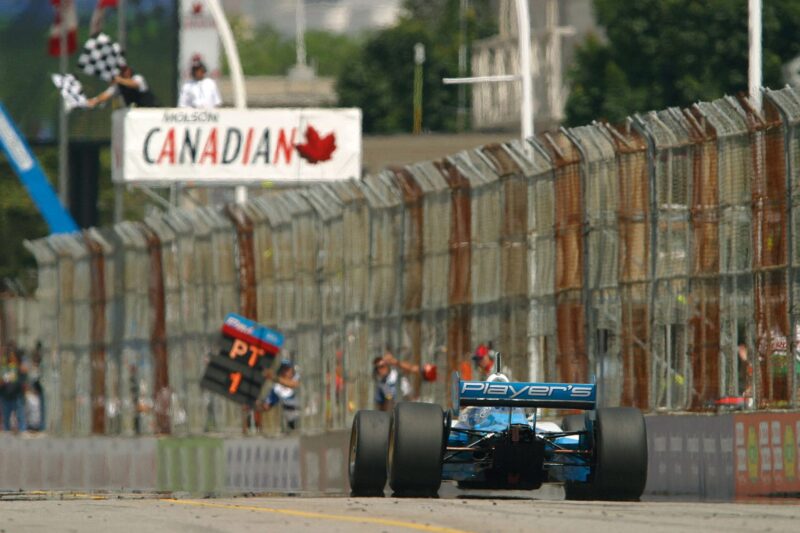
Winning in home town Toronto was a big moment
Motorsport Images
Paul stayed with Team Green for five seasons. In 1999 he scored two wins and seven podiums, and was third in the championship. “Barry hired Tony Cicale away from Forsythe, where he’d been Jacques Villeneuve’s engineer, to work with me and try to ground me. Tony was the best engineer I ever worked with, and we really clicked. In 2000 I had three more wins, including Long Beach again, and six podiums. By 2001 Reynard had taken their eye off the ball a bit – they were getting involved in F1 with BAR – so for 2002 we switched to Lola, and we started winning races again. The CART/IRL split had happened by now, but Barry wanted to do the Indianapolis 500, and bought a car for it. The rules were completely different, using Dallara chassis and Chevrolet engines. We were under-prepared and I qualified 29th, but I came through, right up to second behind Helio Castroneves. On the final lap I passed him on Turn 3. Behind us there was a crash, and the yellow light came on – but by the time the yellows were on, I was already ahead.
“Well, the IRL guys didn’t like a CART guy winning, and the chief steward, Brian Barnhart, decided I’d passed under a yellow. They reverted to the order on the previous lap. Barry appealed, we got all the video and timing stuff together, but they said the steward’s decision had to stand. Look, I still keep the TV footage on my phone. It shows I won that race.
“At the end of 2002 I switched to Forsythe Racing. Tony Cicale was back there as my engineer, and I felt at home there, for the first time I really felt wanted. I had the best season of my career: won seven rounds, including the first three of the season back to back. I had nine podiums, six pole positions, led the points table all year, got my Championship title at last. And I won Toronto and Vancouver, which as a Canadian meant a lot to me.
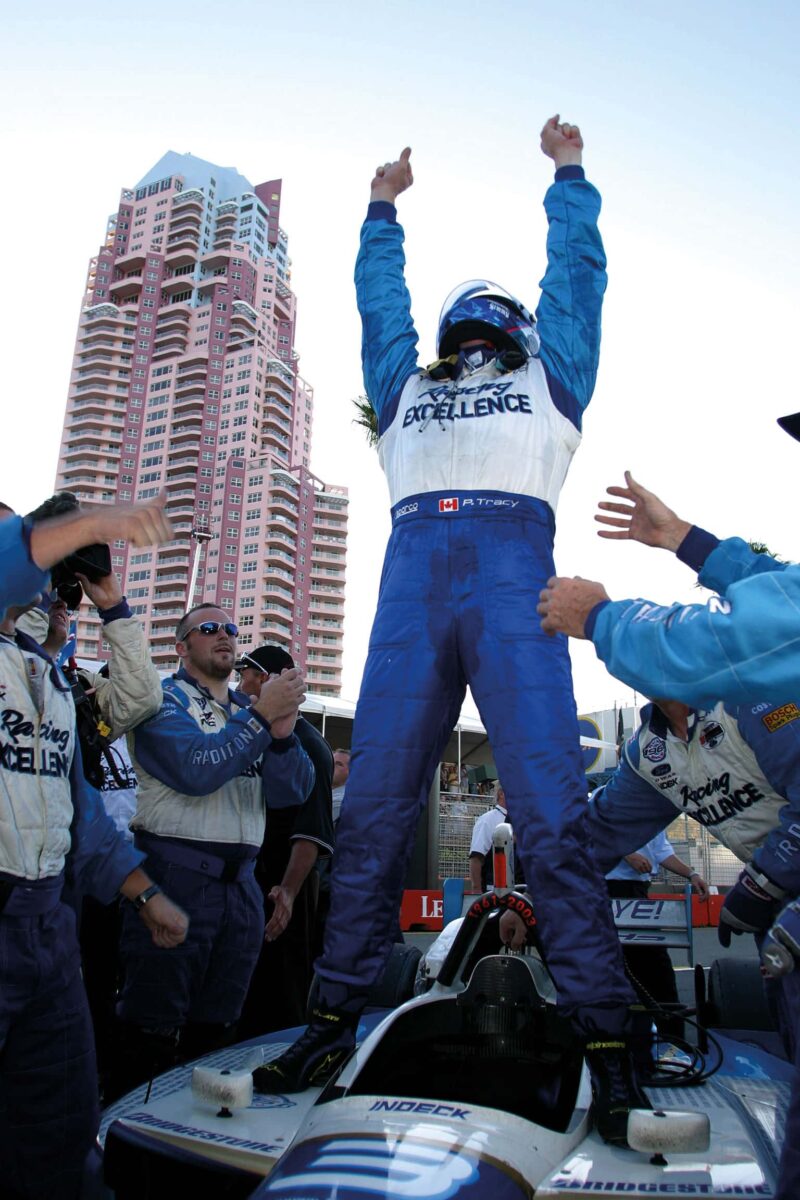
Taking the 2003 CART title in Australia
Motorsport Images
“Once I was champion Gerry Forsythe said he wanted me to drive for him as long as I wanted to keep racing. So I signed a five-year contract, which would take me through to my 40th birthday. Then CART went bust, and Gerry Forsythe got involved in taking it over and running it as Champ Car, with Kevin Kalkhoven. I won some more races in 2004 and 2005, but it was a difficult time. Champ Car was running in opposition to IRL, and NASCAR was growing like crazy and attracting all the sponsors. Meanwhile Gerry and Kevin were having to subsidise the smaller teams to keep the Champ Car grids up.”
In 2006 Paul made the wrong sort of headlines again. “At San Jose in the run-off I spun around and as I rejoined I collected Alex ‘Tags’ Tagliani, a Canadian from Montréal. In the pit lane he came over, screaming in French and grabbing me. I wasn’t happy with myself either – it was 100 per cent my fault – but he was getting in my face. He kept grabbing me, so I decked him. He still had his helmet on, but I punched him right through the eye hole.
“Two weeks later we’re in Denver, I’m running second, Sébastien Bourdais is third. Last lap, I’m having fuel pick-up problems, he catches me on the last corner of the race. We both miss the braking zone by 50 metres, both go sideways, I bump into the side of him, we both spin and stall. He comes running over, I’ve already got my helmet off, he still has his on. He shoves me, I shove him back. Later I said to the media, ‘I’d be happy to fight either of them if they take their helmets off, but French guys want to fight with their helmets on.’
“In 2007 I crashed at Long Beach, trying to win it for the fifth time, and broke my back. I missed several races, but won my second race back, at Cleveland. That was my last Champ Car win. At the end of that year Kevin decided he couldn’t fund Champ Car any more, and Gerry couldn’t do it by himself, so they pulled the plug. Champ Car was sold to IRL, and my contract with Forsythe was over. I did a few races in IRL for Kalkhoven in 2009, but I had to raise the money myself.”
Paul also tried NASCAR. “In 2006 Forsythe released me to do half a dozen races in the Nationwide series with a small team belonging to a guy named Frank Cicci. In NASCAR these days it costs huge money to be competitive. You look at the cars and you think, They’re all the same, but they’re not. The top teams are hand-forming their bodies, they’re in the wind-tunnel every day. The racing is really good, but the cars are terrible to drive. They’re extremely basic. Coming from an open-wheel background where you can adjust your ride-height 20 thou and feel a difference, it’s another world. The top NASCAR drivers, like Jimmie Johnson, are experts at driving bad-handling cars, but you need three seasons to learn how to get the best out of those things.”
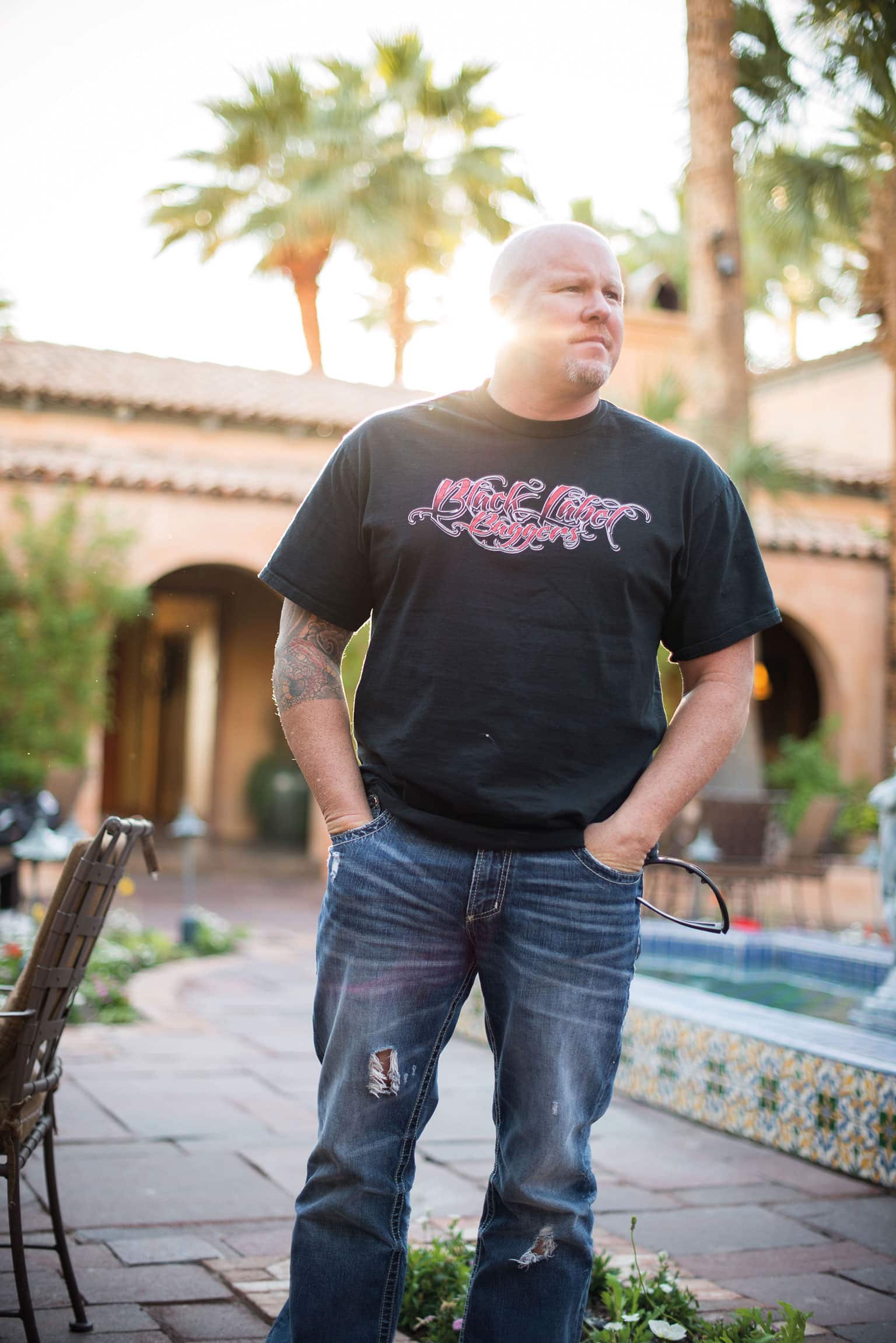
There have been occasional sports car drives at Daytona and elsewhere, but Champ Car’s collapse meant Paul’s plan to keep racing full-time and then retire after a 20-year career never happened. “I was like the poster boy for Champ Car, but once IRL controlled everything I found most doors were shut. So my career definitely didn’t end the way I wanted it to end.”
Paul Tracy’s army of fans say he deserved far more success than he got, and that throughout his career he was often in the wrong place at the wrong time. Certainly, he didn’t always act in his own best interests, and sometimes he was his own worst enemy. But they loved him for what he was: an uncompromising racer who always drove his heart out. In fact, a proper old-fashioned racing driver.
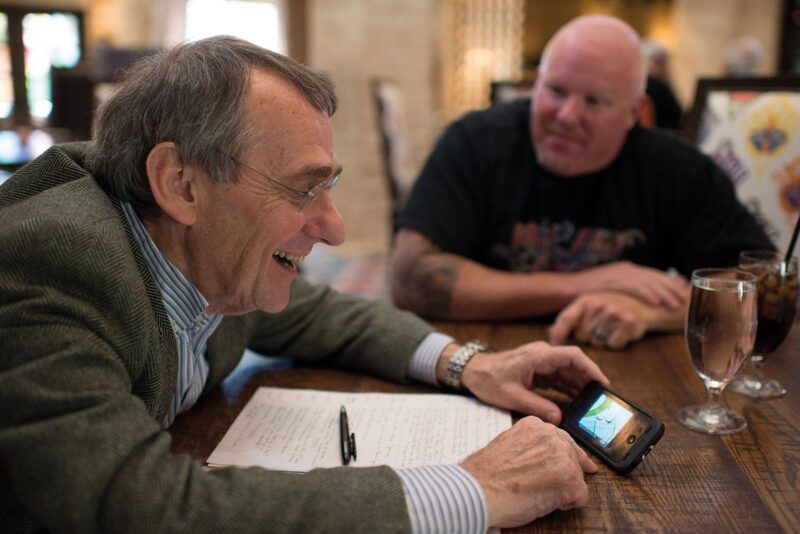
On his mobile, Paul keeps footage that he believes proves he won Indy in 2002
